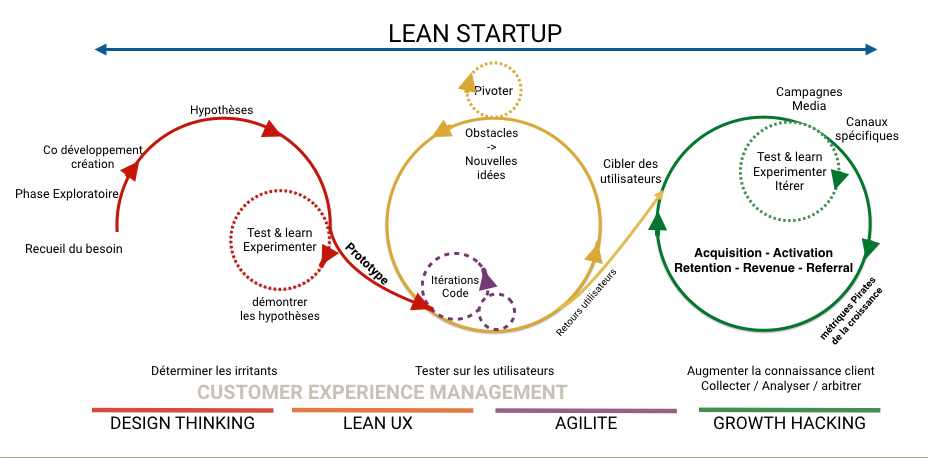
Foreword
This first article on performance aims to present our convictions, concerning the treatment of this theme and to initiate the future themes and articles that we will deal with in the weeks and months to come.
What is digital performance?
Digital performance is an approach/discipline whose essence is to maximize the return on investment when defining and implementing a digital strategy.
Digital performance focuses on optimizing visibility, reputation, audience engagement and brand trust while controlling deployment costs.
Data collection and processing tools are deployed to enable this management. They will guarantee to be able to measure, analyze and arbitrate the means implemented according to the ratio quantified results/costs.
The search for performance, an iterative approach
Iterativity or continuous improvement
Data-based management makes it possible to quantify results and measure changes (progression/regression in relation to a reference period). Learning user behavior and optimizing future deployments are becoming increasingly obvious and almost natural (search for quality increase and elimination of defects).
To this end, we could use the 5 phases of the DMAIC problem solving method (Define, Measure, Analyze, Improve, Control).
- Define the need (what are the client’s goals? Set quantitative objectives to be achieved).
- Measure effects (collect representative data, measure performance, identify areas of progress), with :
- Accuracy (how accurate is the measurement?),
- Repeatability (do we find the same results if we repeat the experiment with identical environments?),
- Reproducibility (do we find the same results if we repeat the experiment with identical environments but by changing the tester?),
- Stability (are accuracy, repeatability and reproducibility stable over time?),
- Analyse (identify the causes of variability, establish a chain of causalities (Gimsi method, Ishikawa diagram, Pearson’s law),
- Improve (define, evaluate and implement optimizations),
- Control (Document optimizations, train teams).
The DMAIC method presents interesting and powerful tools, however we will prefer to apply (in the strict sense) a continuous improvement approach more in line with the start-up of an activity under economic constraint: Lean Startup (Eric Ries).
Lean startup and performance: convergence
Based on Steve Blank’s customer development approach, Lean Startup can be applied to all project contexts:
- Setting up a business,
- Product launch at an advertiser,
- Launch and development of offers in a service company.
The Lean startup approach is based on :
- Experimentation (MVP: Minimum viable product),
- Collection and analysis of user/customer data,
- The adaptation of offers / products based on feedback from users / customers,
- Iteration on the basis of these adaptations.

Digital performance alone is no longer, long live business performance!
Thus the search for performance must be taken in a broader sense than just commercial performance via digital channels or the optimization of the customer experience.
This global approach to performance requires manipulating data from different horizons, more or less structured and analyzing them to highlight causalities or to validate correlations.
This performance should be part of the development of product/service offerings, enabling market share gains (Lean Startup/Analytics – GrowthHacking).
And on the other hand, in an equivalent way, in the optimization of the collaborator experience (for the acquisition-sourcing, the commitment-involvement/dedication, the amplification-cooptation/prescribers of the image of the employer brand, the loyalty or fidelity of the men and women of the company).
The teams involved in these “sprints/working sessions” must be polymorphic and composed of multidisciplinary elements able to adapt to the specific needs of the project/subject.
Optimization tests will have to be implemented with more or less creativity depending on the topics/products addressed. We will have to constantly question our approaches based on the feedback from our audiences/customers in order to adapt, rotate, and tend towards an ever more effective result.
In this context, the opening towards other disciplines and the mixing of skills will produce a new form of expertise where adaptability and versatility will replace excellence in silos.
Future articles will aim to present implementations, through :
- Laws/ statistical concepts from the social sciences
- Data collection tools (Google Analytics, Google Cloud platform, evaluation questionnaires)
- Analysis solutions, reading grids (SWOT, GAP analysis, Brand identity Prism)
- Data processing software accessible to all
- Concepts, methods related to continuous improvement and product launch (5 why, growth drivers, AIDA & KPIs)
And of any other subject informed by our professional experiences / projects, we seem relevant.
Annex :
Eric Ries : Lean Startup
